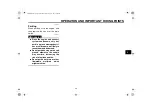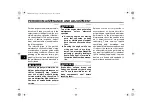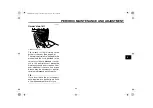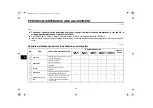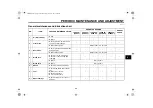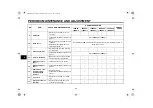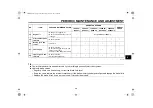
PERIODIC MAINTENANCE AND ADJUSTMENT
6-14
6
EAU21576
Tires
Tires are the only contact between the
vehicle and the road. Safety in all con-
ditions of riding depends on a relatively
small area of road contact. Therefore, it
is essential to maintain the tires in good
condition at all times and replace them
at the appropriate time with the speci-
fied tires.
Tire air pressure
The tire air pressure should be checked
and, if necessary, adjusted before each
ride.
WARNING
EWA10503
Operation of this vehicle with im-
proper tire pressure may cause se-
vere injury or death from loss of
control.
●
The tire air pressure must be
checked and adjusted on cold
tires (i.e., when the temperature
of the tires equals the ambient
temperature).
●
The tire air pressure must be ad-
justed in accordance with the
riding speed and with the total
weight of rider, passenger, car-
go, and accessories approved
for this model.
WARNING
EWA10511
Never overload your vehicle. Opera-
tion of an overloaded vehicle could
cause an accident.
Tire inspection
The tires must be checked before each
ride. If the tire shows crosswise lines
(minimum tread depth), if the tire has a
nail or glass fragments in it, or if the
sidewall is cracked, have a Yamaha
dealer replace the tire immediately.
TIP
The tire tread depth limits may differ
from country to country. Always comply
with the local regulations.
Tire air pressure (measured on cold
tires):
0–90 kg (0–198 lb):
Front:
200 kPa (2.00 kgf/cm², 29 psi)
Rear:
225 kPa (2.25 kgf/cm², 33 psi)
90–167 kg (198–368 lb):
Front:
200 kPa (2.00 kgf/cm², 29 psi)
Rear:
280 kPa (2.80 kgf/cm², 41 psi)
Maximum load*:
167 kg (368 lb)
* Total weight of rider, passenger, car-
go and accessories
1. Tire sidewall
2. Tire wear indicator
3. Tire tread depth
Minimum tire tread depth (front and
rear):
1.0 mm (0.04 in)
U40BE2E0.book Page 14 Wednesday, October 10, 2012 8:01 AM

